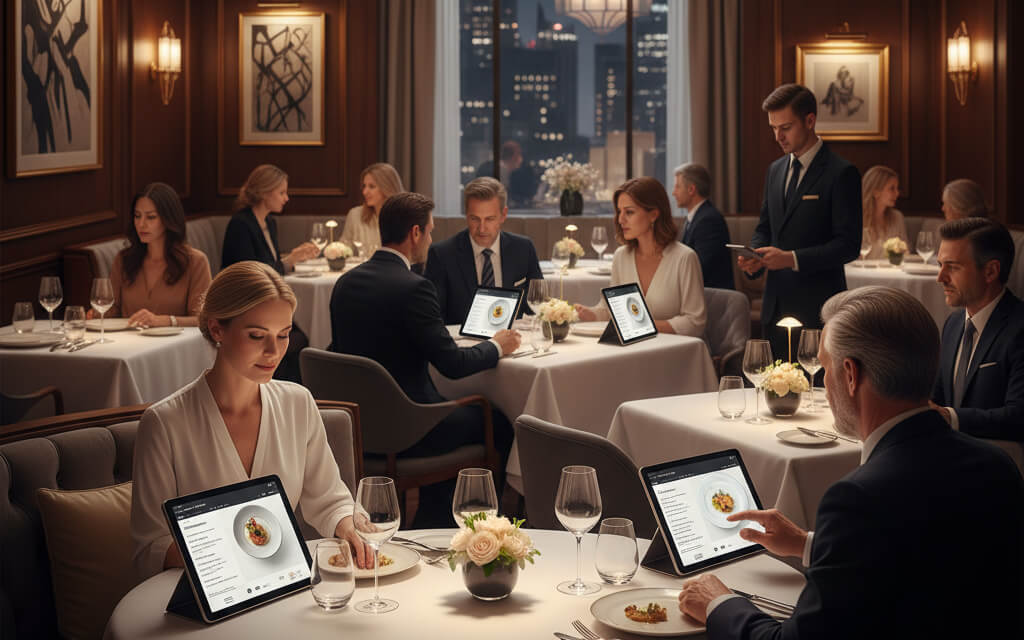October 14, 2025

Fine dining has long stood as the pinnacle of culinary sophistication — where artistry, exclusivity, and flawless service intertwine. Traditionally characterized by white-glove treatment, multi-course tasting menus, and iconic interiors, the fine dining world was once defined by predictability and ritual.
However, the global COVID-19 pandemic changed the fabric of hospitality. What once symbolized luxury — formality, grandeur, and exclusivity — began to feel distant, even inaccessible, in a world craving comfort, safety, personalization, and convenience.
Today, luxury is less about opulence and more about intentionality. Diners are no longer simply paying for a meal — they’re seeking connection, meaning, and experiences that align with their values. As a result, the fine dining industry is undergoing a cultural and technological transformation that will define the next generation of culinary excellence.
Today’s luxury diners want the best of both physical and digital worlds — a “phygital” experience. This means more than just having an app or online reservations. It’s about deeply integrated digital touchpoints that enhance personalization before, during, and after the meal.
Examples of digital personalization:
Tock, OpenTable, and newer platforms like Bbot have become essential tools for fine dining brands looking to provide seamless and thoughtful guest experiences.
According to this article on online ordering investments, restaurants — even at the luxury level — benefit from digitization by streamlining internal processes while offering guests a sense of prestige through personalization.
“Digital isn’t the opposite of luxury. Today, it’s the foundation of it.”
— Rachel Mansfield, Hospitality Tech Strategist
Traditionally, personalization required staff memory and intuition. Now, digital guest profiles can provide insights at scale:
This level of micro-personalization isn’t just impressive — it’s expected. And when done right, it turns first-time diners into lifelong patrons.
The narrative that technology “kills hospitality” is outdated. In fact, tech frees up staff to do what they do best: connect with guests. By automating routine tasks — reservations, order input, billing, and staff scheduling — restaurants allow teams to focus on attentiveness, storytelling, and emotional intelligence.
Examples:
According to this report on reducing turnover through technology, restaurants that leverage smart systems not only improve guest satisfaction but also reduce employee burnout — a critical need in today’s labor-challenged environment.
With better tools, staff can:
This isn’t about robotic service — it’s about human service, augmented by data.
Before 2020, it was unheard of for Michelin-starred restaurants to offer takeout. The idea of luxury meals in cardboard containers felt antithetical to the fine dining ethos. But the pandemic forced a re-evaluation, and the results were surprisingly elegant.
Chefs and restaurateurs began to ask: What does luxury look like at home?
The answer came through meticulously designed packaging that extended the restaurant’s identity:
According to this article on takeout packaging, packaging has become a key brand asset — not just functional, but emotional and aesthetic.
Today’s affluent diners are also eco-conscious. They want experiences that align with their values, especially sustainability. Brands like Eco-Products, PakTech, and Loliware (edible utensils and straws) help high-end restaurants serve elegance with a conscience.
“A reusable box with compostable elements signals that the restaurant respects not just you, but the planet.”
— Ana Ramos, Culinary Packaging Designer
The long closures during COVID-19 disrupted the emotional ties between guests and restaurants. For fine dining venues, whose success often hinges on loyal regulars, reconnection became a priority.
Digital marketing, once an afterthought, is now a pillar of customer retention.
Tools like Meta Ads Manager and Google Ads allow restaurants to run:
According to this guide, smart ad strategies lead to higher ROI than traditional marketing — especially for luxury brands that rely on word-of-mouth and curated reputation.
Upscale restaurants are also leveraging content marketing:
Luxury diners want connection, not just consumption. By bringing guests into the creative process, restaurants build loyalty through authentic storytelling.
Sustainability isn’t just a trend — it’s redefining what refined means. Diners increasingly ask:
Fine dining venues are now expected to lead the charge in ethical sourcing, low-waste kitchens, and local partnerships.
Examples:
Sustainability has become part of the guest experience — and the expectation. A restaurant that uses rare imported ingredients flown from multiple continents may appear extravagant but feel out of step with the times.
Modern fine dining must balance indulgence with intention.
In a crowded marketplace, some of the most successful restaurants are redefining the dining room as a stage. From multisensory design to choreographed service, fine dining is leaning into experiential storytelling.
Examples of experiential dining:
“Guests don’t want to just eat luxury — they want to feel it. They want a story that engages every sense.”
— Lars Hemmingsen, Experience Designer
Immersive dining creates memorable emotional connections, not just culinary impressions. That connection — whether through surprise, joy, nostalgia, or awe — is what sets a truly great restaurant apart.
Luxury used to mean exclusivity — but today, it increasingly means inclusivity. Diners want to feel welcomed and represented, regardless of dietary needs, background, or beliefs.
Modern expectations:
— such as alcohol-free pairings, low-sodium dishes, or meditation-enhancing ambience.
Restaurants like Eleven Madison Park (which pivoted to a fully plant-based menu) and ONA (France’s first vegan Michelin-starred spot) are examples of how fine dining is embracing wellness and diversity as a core value.
Fine dining is no longer static. It’s fluid, responsive, and multidimensional. The most successful restaurants of tomorrow will be those that:
Because in this new age of hospitality, the most luxurious offering isn’t foie gras or caviar — it’s the feeling of being seen, respected, and delighted in a way that no algorithm could replicate, yet every smart system helps deliver.
Stay up to date with the latest tips, expert insights, product reviews, and step-by-step guides to help you grow, create, and succeed—no matter your industry or passion.